Tree Pruning: Various Methods Used to Prune a Tree
- Date: 29/Mar/2024
- Comments: 2
There are many ways to carry out tree pruning and in this article I go over the various methods used and the right and wrong way to perform pruning.
Tree Pruning: Crown Lifting
Tree crown lifting is the selective removal of the trees lower branches and the trimming of foliage.
It raises the height of the crown and increases the clear space from ground level up to the bottom part of the trees crown.
Tree crown lifting can be carried out for many reasons, for instance:
- To provide clear and safe access to footpaths and roads for pedestrians and cars to pass by and to provide accessible, clear parking spaces beneath a tree’s branches
- To prevent low branches from obstructing fences, driveways, buildings, or to provide space for mowing lawns, etc
- To allow more light to pass under the tree
Tree crown lifting is highly skilled work and requires a vast amount of tree knowledge and many things need to be considered when undertaking this type of tree surgery.
It is, therefore, imperative that you only employ a highly competent, registered and insured tree surgeon to do this work for you.
British standard BS3998:2010 recommends that the lifting of a tree’s crown is no more than fifteen percent of the live crown height.
Also, it is advised that any large, primary limbs which grow directly from the trees trunk should be left alone where possible.
Removing primary limbs could cause significant wounds and this could leave the tree open to disease and decay setting in.
Tree crown lifting should be carried out before a tree matures but where this is unavoidable.
Mature trees should only have their secondary limbs removed to minimise the amount of stress the tree may suffer and also help speed up the healing process.

Tree Pruning: When to Carry Out Tree Crown Lifting
Generally, the best time of year for undertaking tree crown lifting is during the late summer while the tree is still in full leaf.
The tree will then be bearing its full weight thus ensuring that the trees branches will be at their lowest level.
This will then enable the tree surgeon to be better able to assess how much lift will be necessary to create the required space below.
A tree surgeon will be able to advise the best time of year to carry out this type of work for your particular tree, along with advising if this kind of pruning is the best option.
Tree Pruning: Crown Thinning
Tree crown thinning is carried out to reduce the density of a trees crown and is normally restricted to the selective removal of secondary branches along with any branches that may be crossing, rubbing, damaged or dead.
As well as allowing more air and light to pass through the tree, tree crown thinning also helps to reduce the weight of the crown along with reducing wind resistance, all of which makes for a stronger and healthier tree.
Tree crown thinning is normally done as a percentage of up to no more than thirty percent and when carried out correctly this type of pruning will not change the trees overall size and shape.
Tree crown thinning is normally carried out on broad leaved trees as opposed to conifers and is a commonly used method for the pruning of fruit trees.
Tree crown thinning can be carried out for many reasons, for instance:
- To increase the amount of light that passes through the canopy thereby reducing shading
- To reduce the weight of the crown and to remove dead, weak, crossing or damaged branches, thereby improving the overall health of the tree
- To reduce crown resistance to strong winds helping to minimise damage to branches
Tree crown thinning is a very skilled procedure and gives a much more subtle effect than crown reduction when carried out correctly.
It is therefore best to leave this type of pruning to professional tree surgeons as it is all too easy to spoil the trees appearance, not to mention injure yourself in the process!
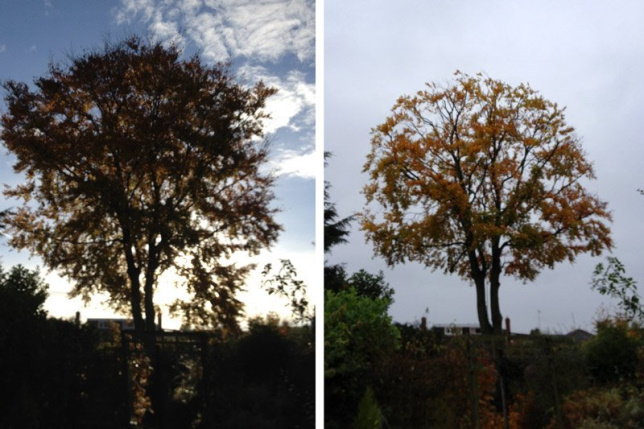
Tree Pruning: Crown Reduction
Tree crown reduction is when the overall size of the crown is reduced by a specified amount of normally between ten to thirty percent, with the ends of branches being evenly pruned throughout the crown whilst leaving foliage intact to the outer edge of this smaller, new canopy, resulting in a balanced, well-shaped tree.
When done well the resulting shape should remain true to that particular species, with the aim that when standing back from the tree, pruning cuts should not be evident once crown reduction has been completed.
Tree crown reduction can be carried out for many reasons, for instance:
- To reduce the weight to a potentially dangerous tree
- When a tree is casting too much shade or may be liable to damage a building
- To prevent a tree from growing into overhead cables
Tree crown reduction is a much better alternative to tree felling, particularly when a customer does not wish to lose a much loved tree or if the tree is subject to a tree preservation order.
As tree crown reduction is highly skilled work and often requires a method of pruning known as drop-crotching it is vitally important that when employing a tree surgeon to carry out this type of work only a registered, highly competent company with a proven history is used.
A knowledgeable tree surgeon will also be able to advise you on the best percentage of reduction for your tree species. This will ensure that the final results are not only structurally sound but aesthetically pleasing too.

Tree Pruning: When to Carry Out Tree Crown Reduction
The best time of year for undertaking tree crown reduction to broadleaved trees is in the winter or early spring whilst they are still dormant and before the sap starts rising.
Spring, when the sap is rising is the worst possible time as this may cause the tree to bleed, resulting in stress, ill health and possible death.
Sometimes it may be necessary to reduce a tree whilst it is still in full leaf and while this is not necessarily harmful it is best avoided whenever possible.
As with all things, there are always exceptions to any rules but your chosen tree surgeon will be able to advise you about that.
It would be as well to remember that is type of pruning will only be temporary and depending on the health and type of tree involved.
It will revert back to its natural size after a period of time and using crown reduction as a way to continually keep a tree at a small size may cause the tree to decline, for example beech trees in particular do not respond very well to this particular method of reduction.
A good tree surgeon will have vast experience and knowledge and will therefore be able to tell you if this type of pruning is suitable for your tree and if not, will advise of a better, alternative method, so do discuss it fully with them, after all, they do love talking about trees and the work involved!
Tree Pruning: Tree Crown Cleaning / Dead Wooding
Tree crown cleaning is to remove from the crown or canopy, as it is sometimes referred to, of a tree any dangerous, diseased, weak, crossing, dying or dead wood and will often also include the removal of unwanted water shoots, climbing plants such as ivy and the stumps of broken or badly cut branches from previous surgery, along with any other debris that can often end up in trees.
Tree crown cleaning helps to minimise the chances of falling branches and it is therefore particularly important to carry out this procedure periodically on all urban trees that may pose a risk to people passing by or parked and passing vehicles and should also include for example the grounds to schools and colleges and local parks and any other public locations.
Other reasons for tree crown cleaning can include:
- To reduce the trees weight thereby preventing branches from breaking off
- To improve the appearance of the tree and to increase the amount of light that can pass through it
- If dead wood is left to remain in a tree rot may well set in and it may also attract pests and diseases, therefore regular cleaning will help to ensure the continued good health and appearance of a tree
As tree crown cleaning requires the tree surgeon to climb over the entire canopy of the tree it is dangerous work, which is often carried out at height and therefore you should not consider doing this yourself but engage the services of a registered and fully insured local arborist.
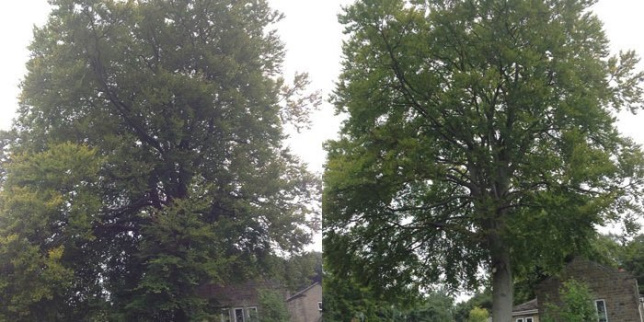
Tree Pruning: When to Carry Out Tree Crown Cleaning / Dead Wooding
Although this procedure can be carried out at any time of year it is far easier for the tree surgeon to see exactly what’s what when the tree has lost most or all of its leaves.
If you think your tree may need crown cleaning then contact a reputable and correctly insured, registered tree surgeon who will come and take a look at your tree or trees to see if this work is necessary and provide you with a quotation.
Tree Pruning: Pollarding
Pollarding is a form of pruning that involves the dramatic cutting back of branches from a tree leaving the trunk supporting between 3 to 5 much reduced branches, with the result that the tree looks almost bare until new, twiggy growth starts to appear at the ends.
This pruning method is then carried out annually, thus keeping the tree smaller than it would naturally grow.
Pollarding can be carried out for many reasons, for instance:
- It will stop a tree from outgrowing its given space
- To reduce the amount of shade that a tree may be casting
- To prevent a tree from growing into overhead cables
You may have noticed that street trees and the trees in your local park have been pruned using this method as Local Councils often hire tree surgeons to manage their trees by pollarding.
You can’t fail to notice them as pollarded trees certainly take on a strange appearance when first cut, rather like having had a fully shaved head, but new growth is quickly produced.
Pollarding can also help to rejuvenate a tree, extend its lifespan, lessen its vulnerability to high winds and will also reduce excessive weight.
Most of Richmond Parks 500 to 700 year old veteran oak trees have actually survived to such a great age because they are pollards.
Interestingly, pollarding has allowed these veteran oaks to now support may rare invertebrates and although these veteran oaks will probably live for a further few hundred years, when they are gone there will be no suitable pollarded oaks to replace these veterans and thus support the rare invertebrates.
It is for this reason that back in 2002 Richmond Park selected fifty young oak trees to be pollarded and they now regularly pollard a small number of young trees each year, ensuring a future generation of veteran trees, thereby conserving Richmond Parks continued ecology.
Many trees will benefit from being pollarded with some of the more common trees found growing in London gardens being:
- Ash
- Common Lime
- Elm
- Elder
- Hornbeam
- London Plane
- Maple
- Mulberry
- Oak
Pollarding will normally need to be carried out by a qualified tree surgeon as it usually involves working at height with a chainsaw. Pollarding is a dangerous job that requires great skill and knowledge.
If you think that you have a tree that will benefit from pollarding then talk to your local tree surgeon but do keep in mind that once a tree has been pruned by this method then pollarding will need to be carried out annually or at least every few years to avoid problems from arising (more about that later) so can become quite expensive.
Talk it over with your chosen tree surgeon, they may advise that crown reduction or crown thinning would be a better option.
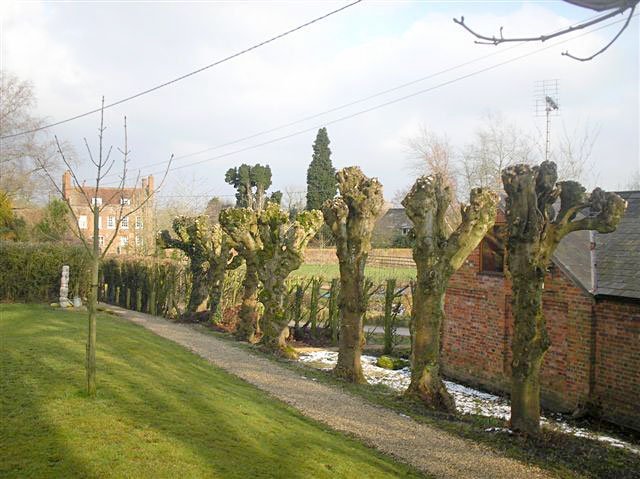
The Best Time of Year to Undertake Pollarding & Maintaining a Pollard
The best time of year for most trees to be pollarded is during late winter to early spring but there are of course always the odd exceptions, for example an Acer should not be pruned in spring as they are likely to bleed sap. A qualified tree surgeon will be able to advise you of the best time of year for your particular tree.
Pollarding is best avoided during the autumn to prevent decay fungi entering the pruning cuts.
Once a tree has been pollarded it will be necessary to keep up with the yearly cycle of cutting, with branches being pruned to just above the previous cuts. If leaf cover is required then some branches may be left intact or else cut back to a side branch.
When a Pollarded Tree has been left to become overgrown
Not everyone realises that a pollarded tree will need to be maintained regularly. Perhaps you have purchased a new house and have inherited an already pollarded tree in the garden and now it has become overgrown.
Neglected pollards can be a problem and cause hazards, for example some trees such as willows and poplars have weak wood and this may cause any weakly attached branches to snap and fall off. Ask your local arborist to visit and carry out a safety check and to then carry out a regular cutting cycle.
Similarly, where pollarding has lapsed for a number of years on trees such as sweet chestnut, oak and beech, the branches can become very heavy and are liable to break off during windy weather.
Trees should always be monitored after major work has been undertake in case further maintenance is needed.
Incorrect Pruning & the Resulting Outcome
Beware of people calling themselves tree surgeons when they are neither trained, insured, registered, have very little real knowledge about trees and don’t even have the correct tools, safety equipment or clothing.
Whilst no doubt some of these people will advertise on the internet or in local papers and shops, most are just chancers and alarm bells should certainly ring when one knocks on your door touting for work.
Below is a guide to some of the things they may offer and the resulting consequences of hiring one, so please, do be aware and look out for these issues.
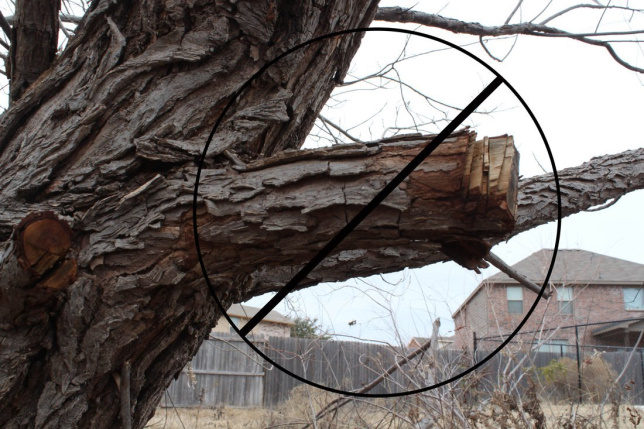
Tree Topping
Tree topping is a form of extremely hard pruning where nearly all the trees branches and foliage are removed (and not to be confused with pollarding) thus totally destroying the trees shape from which there is no coming back even if the tree survives this brutal treatment.
Green foliage is a trees source of food production and with such heavy pruning this valuable source will be lost for some considerable time depriving the tree of nutrients.
The location and size of these cuts will affect the trees ability to close its wounds leaving it completely vulnerable to pests and diseases.
This heavy pruning will also cause the tree to develop extensive amounts of water sprouts which grow on to become weakly attached branches making them prone to failure.
This could go on to cause you to become liable should someone be hurt or even killed from these weakened branches and of course, if nothing else, it will give rise to further maintenance being necessary, thus incurring additional expense.
It someone offers you tree topping or lopping for that matter – run a mile!
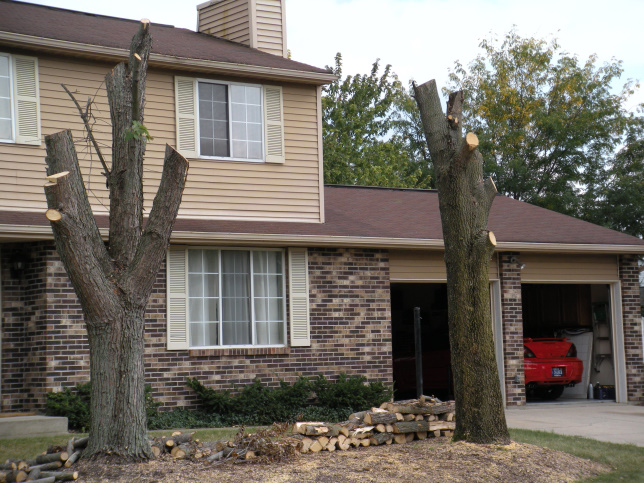
Tree Lion Tailing
This is when only the interior branches are removed from the canopy, causing the ends of branches to bear too much weight making them over elongate.
The end results may be a weakened branch structure leading to breakage, can reduce branch taper, cause sunburn to the tree, along with causing the tree to develop unwanted water sprouts.
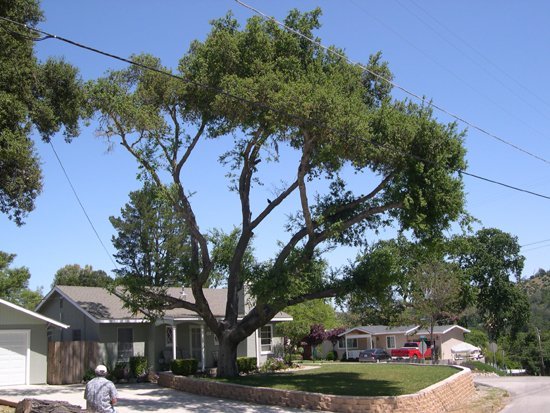
Over Lifting a Tree
This is a fairly common practice amongst untrained, so called tree surgeons who lack the required knowledge to carry out the correct method of pruning and is usually carried out on large trees or when they are trying to undertake tree crown raising, with the hapless bodger removing either most or all of the interior, low branches.
These interior branches are a further source of food needed by trees to enable them to function correctly and defend themselves against the various different threats they are often exposed to.
Removing so much of the trees live tissue will badly affect the health of the tree and also results in a low crown ratio with the tree becoming much more prone to failing.

Flush Cuts
This is when a cut is made into the branch collar resulting in a flush cut.
When a pruning cut is made flush with the trunk it causes damage to the branch collar and results in a much larger wound than should be necessary. The result is that the trees trunk is left open to decay, increasing the chances of disease and infection setting in along with causing cracks to the trunk.
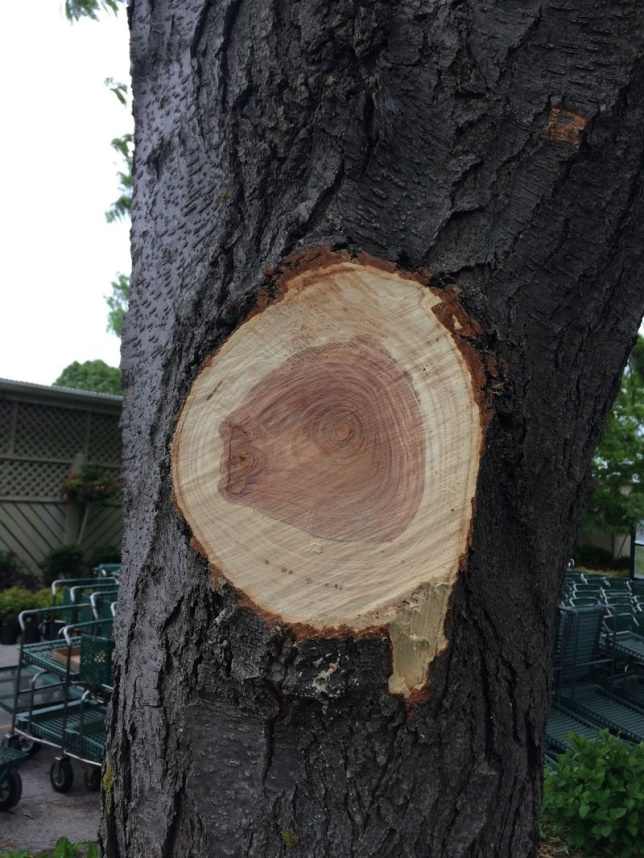
Long Stub Left Remaining After Pruning
This is when a pruning cut is made well beyond the branch collar and therefore leaves a branch stub behind.
This stub, particularly whilst the cut is still open to the air may become vulnerable to wood decaying organisms until the wound has a chance to heal. When decay starts in a stub it can actually move into the trunk by breaking through the branch protection zone which may, in turn cause the trunk to rot.
It will also increase the chances of the trunk and or branch to fail.
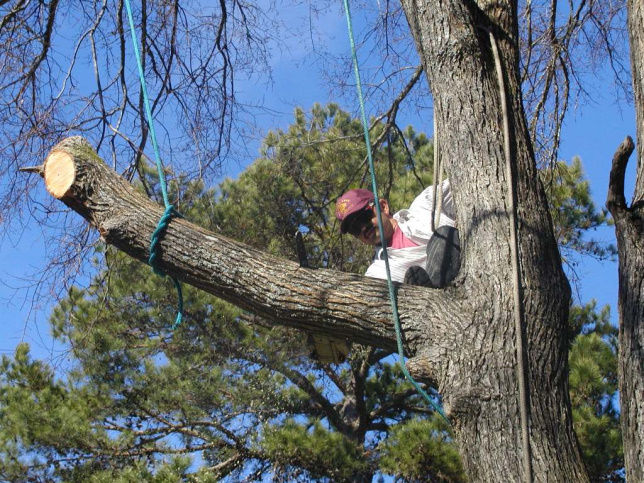
Pruning Cuts That Are Too Large
When a large pruning cut is made outside the branch collar it results in a large amount of heartwood being exposed, thus creating a large wound and this in turn then increases the chances of disease, infection and decay setting in.

Bark Tearing
Tears to tree bark are just another example of extremely bad workmanship that no self-respecting tree surgeon would ever do and happen when a pruning cut is improperly made either through lack of knowledge, through badly maintained tools or due to using the wrong tools.
This tear will damage the branch collar, affecting the trees ability to close its wound, which may then lead to possible decay setting in.
One of the things tree bark does is to protect the inner bark.
This inner bark has the important job of bringing the food produced by the foliage to the whole of the tree so it clearly needs that protection (this is one of the reasons I get so mad when people stick drawing pins into trees – it has the same effect as sticking one into our own arm, causing an open wound where infection can easily enter).
I have heard of people being fined by their local council for putting up notices in this way but not often enough unfortunately!
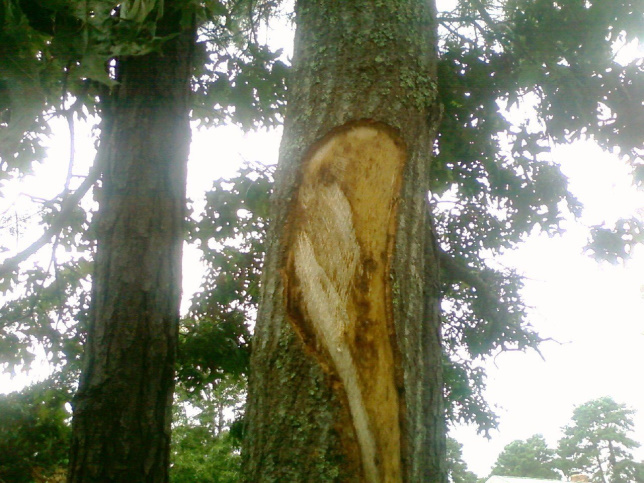
Jagged Wounds left on Trees after Pruning
Tools not only need to be the correct size for the cut that needs to be made they also need to be sharp enough to be able to give a clean cut that will prevent jagged wounds being made in the first place.
A jagged wound is not able to close as well as a clean cut which will then cause more, extensive decay to set in thereby leading to more broken branches.
A jagged wound also affects the trees ability to move nutrients, thus causing the trees overall health to suffer.

Conservation Areas
If you live in a “Tree Conservation Area” then you will need to apply to your local council for permission to carry out this work.
When engaging a tree surgeon to carry out work for you most will offer this application process as a free service. As they are well versed in filling out the necessary forms and of the requirements of the various different councils in their area, this will normally result in a more favourable answer from the local council than you or I could achieve.
It also saves the headache of form filling which many of us certainly do not enjoy to boot!

Tips for Finding a Reputable Tree Surgery Company:
A handy way to secure the services of a good tree surgeon is to watch any you see in your local area and see how they conduct themselves.
Make a note of the company and check them out on the internet for the necessary British standard certificates, qualifications and insurance and then return to where you saw them working a few days later to view the results.
Perhaps knock on the door of the householder to ask their opinion of how it all went or check their reviews on checkatrade.
Article was written by Karen Arnold.
Edited by Conner D on 29/03/2024.
Article Source: https://www.graftingardeners.co.uk/tree-pruning-various-methods/





























2 comments on “Tree Pruning: Various Methods Used to Prune a Tree”
How do you repair a wound such as in your picture “Jagged Wounds left on Trees after Pruning”?
Hi Gary F,
When a tree is damaged by flush cuts or branch breakages there is no real way to repair the wound.
The only thing you can do is cut off any rugged or loose bark around the edges with a sharp blade, i.e. Stanley knife.
Dressing the wounds with tar or paint is not recommended as it will often interfere with the wound closure and can encourage fungal growth.
Hope this helps.
Regards,
GraftinGardeners Team.